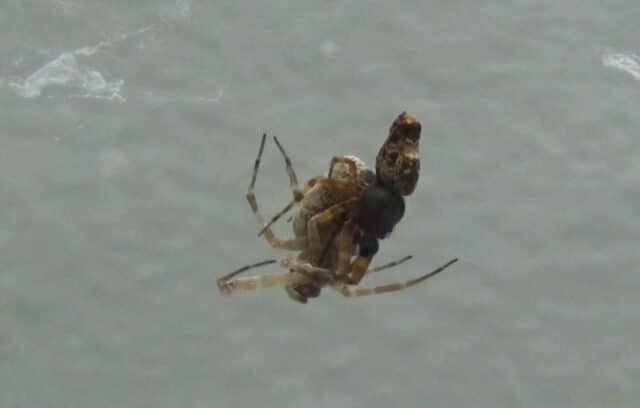

To avoid being eaten by their partner after sex, males of the spider species shoot Philoponella prominens himself away from her at high speed.
Taking a breather and maybe smoking a cigarette after the act is not an option with many spider species. Quite a few female spiders tend to sink their teeth into the male they just mated with.
But males of the spider species Philoponella prominens – belonging to the same family belong as, for example, the garden spider – have found something on that. They fold their two front legs in half against the female and, as soon as the sex is over, they unfold those legs again and shoot away. The process is “similar to the operation of a catapult,” write a biologist Shichang Zhang from Hubei University in China and colleagues in the scientific journal Current Biology†
Up to six times
Those escape jumps are also quite spectacular. The spiders reach speeds of up to 88 centimeters per second, Zhang and his team found. During their jump, they also spin an average of 173 times per second, with peaks reaching 469 times per second!
How did the researchers determine that? “We filmed the pairings with a high-speed camera that shoots 1,500 frames per second,” team member Li Daiqin explains by email. In doing so, the scientists looked at how the positions of three points on the male spider’s body changed per figurine. On the basis of these displacements, they then calculated the trajectory that the spider traveled while catapulting away.

Two mating spiders of the species Philoponella prominens†
In addition, such a male is attached to a ‘safety line’ made of spider silk, the researchers write. Along that line, it can climb back to the female’s web after its jump—to mate with her again and catapult away again. The male can do this up to six times in a row, the researchers found.
Broken catapult
As is sometimes the case with biological research, Zhang and his team also did some rather… cruel experiments. For example, in thirty males they held a brush against their backs, so that they could not jump away after mating. “All these males were captured and killed by the females,” the researchers wrote.
They also removed one or two front legs from sixty males, so that their catapult mechanism no longer worked. These mutilated spiders still courted the females, but then did not mate with them. Males with one or two of the other six legs removed did mate with their female. And then catapulted away.
Of excellent quality
Andrés Rivera Quiroz, PhD in spider research and now working at Naturalis, considers the study of excellent quality. “Many spider species are difficult to study because they only show their normal behavior under very specific conditions. 155 pairings were studied for this study – which is quite a lot! — and more than 97 percent of those showed the slingshot mechanism.”
Rivera Quiroz calls that mechanism “very surprising”. “In spiders, you see all kinds of phenomena related to sexual selection: battle between males, an arms race between males and females, genital mutilation, sexual cannibalism… But I had never heard of such a slingshot mechanism.”
Source material:
†Male spiders avoid sexual cannibalism with a catapult mechanism” – Current Biology
†These male spiders catapult at impressive speeds to flee their mates before they get eaten” – Cell Press
Andres Rivera Quiroz (Naturalis Biodiversity Center)
Image at the top of this article: Shichang Zhang